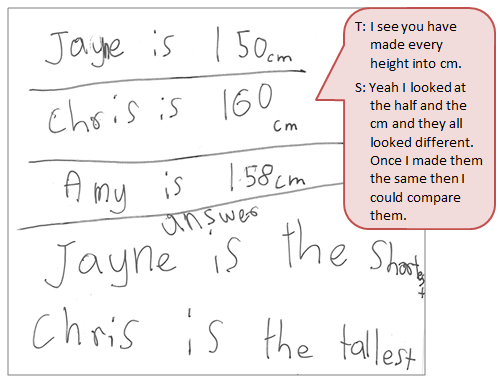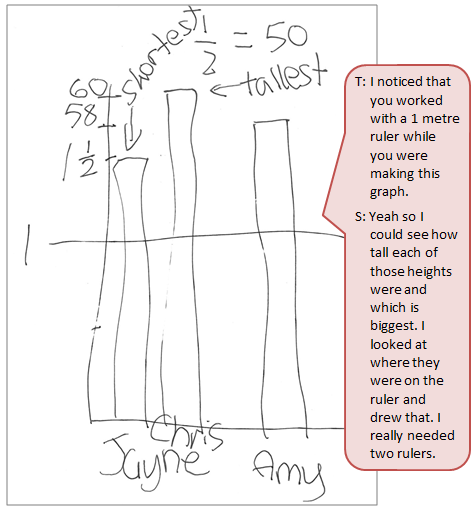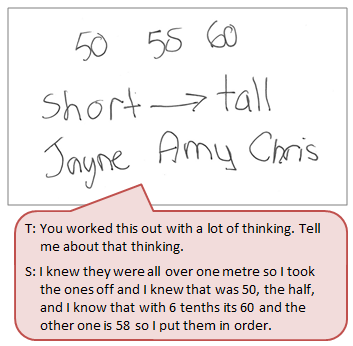The purpose of this activity is to engage students in applying their number knowledge to compare measurements of the same type but given in different formats.
This activity assumes the students have experience in the following areas:
- Working with metric units of length, especially metres, centimetres, and millimetres.
- Converting between centimetres (cm) and millimetres (mm).
- Using a ruler to measure length and distance.
- Working with decimals to 2 decimal places.
- Expressing part-whole relationships as fractions.
- Ordering measurements of length.
The problem is sufficiently open ended to allow the students freedom of choice in their approach. It may be scaffolded with guidance that leads to a solution, and/or the students might be given the opportunity to solve the problem independently.
The example responses at the end of the resource give an indication of the kind of response to expect from students who approach the problem in particular ways.

Three friends measured their heights:
- Jayne is one and a half metres tall.
- Chris is 1.6 metres tall.
- Amy is 1 m 58 cm tall.
Who is the tallest and who is the shortest?
Show how you know.
The following prompts illustrate how this activity can be structured around the phases of the Mathematics Investigation Cycle.
Make sense
Introduce the problem. Allow students time to read it and discuss in pairs or small groups.
- Do I understand the situation and the words? (Students should recognise that the measurements are expressed in different ways.)
- What are the important words and symbols? (The measurement units of metre, and centimetre are important, as is the relative size of the units. Making sense of the fraction ½ and the decimal 1.6 is also needed.)
- Does this look/sound like a problem I have worked on before? (Students might recall ordering students for the class photograph or reading heights of sports players.)
- What will my solution look like? (The solution will be a decision on the order of people by height with an argument that justifies the order.)
Plan approach
Discuss ideas about how to solve the problem. Emphasise that, in the planning phase, you want students to say how they would solve the problem, not to actually solve it.
- What are the maths skills I need to work this out?
- What strategies can I use to get started? (Physically acting out the problem or drawing a diagram are useful first steps.)
- How will I compare the heights when they are written differently? Can I find a common unit?
- What tools (digital or physical) could help my investigation? (Ensure metre rulers are available to students.)
Take action
Allow students time to work through their strategy and find a solution to the problem.
- Am I recording my workings in a systematic way, so I don’t miss anything?
- Do I know how to use my tools, or should I ask for help?
- Does my answer seem correct? Is it what I expected?
- How do my results look the same or different to others? Why could this be?
- Does my solution answer the question?
- Is there another possible answer or way to solve it?
Convince yourself and others
Allow students time to check their answers and then either have them pair share with other groups or ask for volunteers to share their solution with the class.
- What is the solution?
- Is my working clear for someone else to follow?
- Could I have solved the problem in a more efficient way?
- Which ideas would convince others that my findings answer the investigation question?
- What connections can I see to other situations, why would this be?
- What maths have I learned?
Examples of work
Work sample 1
The student coverts each height measurement to a common unit and makes correct comparisons.
Click on the image to enlarge it. Click again to close.
Work sample 2
The student draws a diagram to represent the heights of the three people and uses the diagram to successfully order the heights.
Click on the image to enlarge it. Click again to close.
Work sample 3
The student concentrates on the fractional part of each height. They express the part of the heights more than one metre using centimetres by making sense of fractions and decimals. Using whole numbers of centimetres, they compare the heights correctly.


